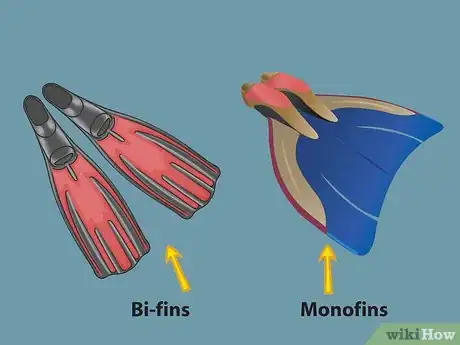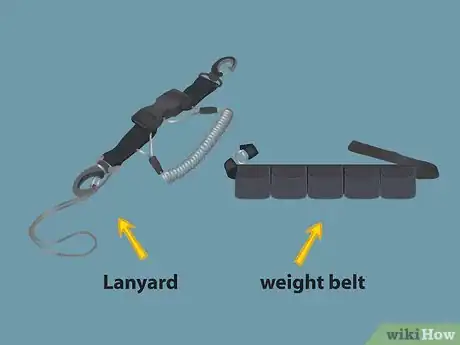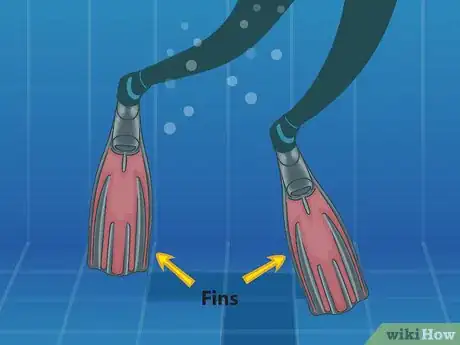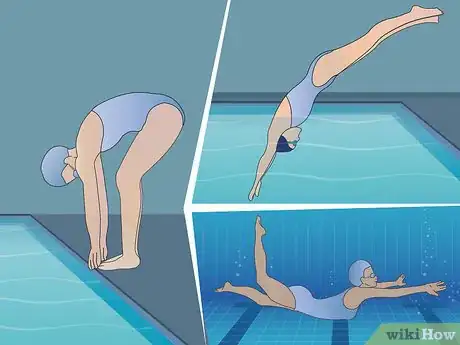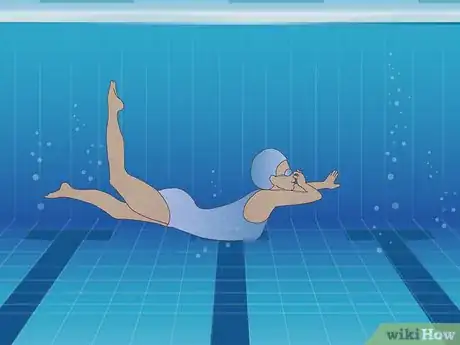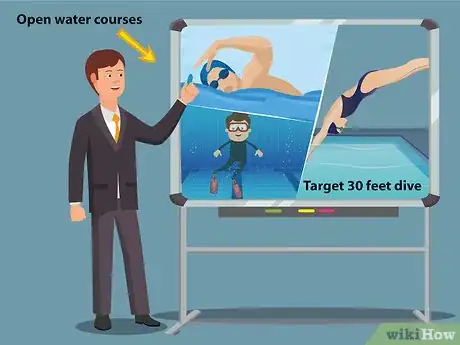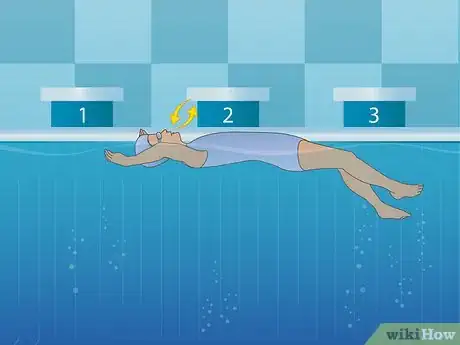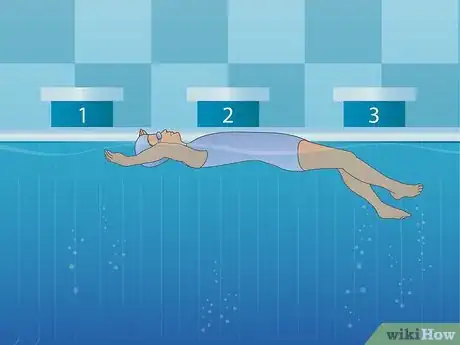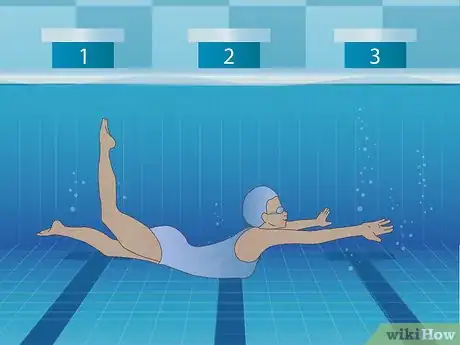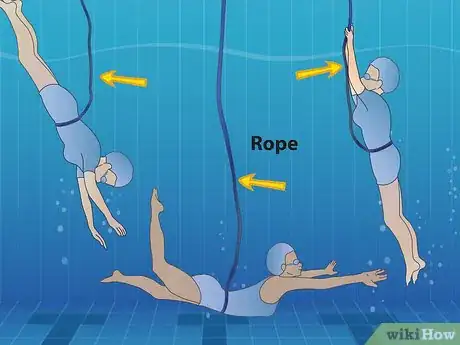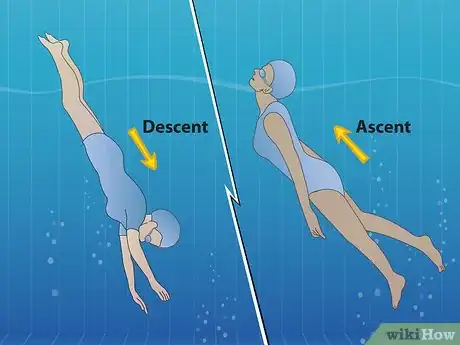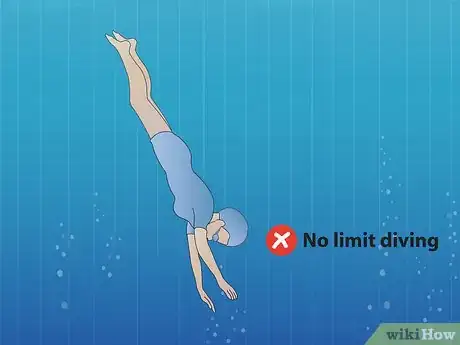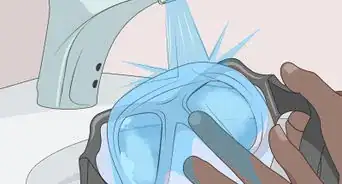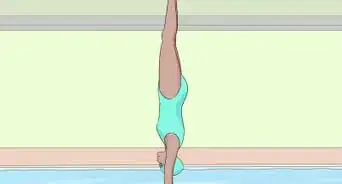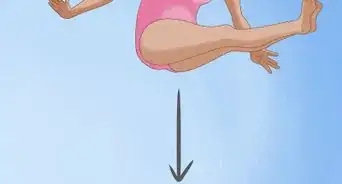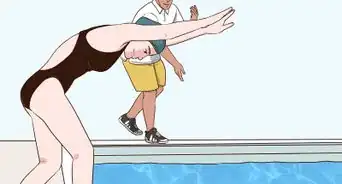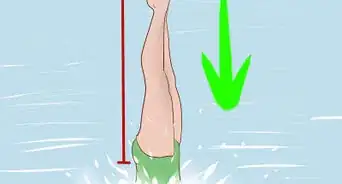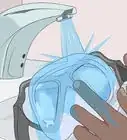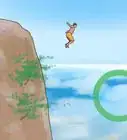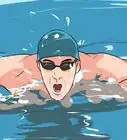This article was co-authored by Brad Hurvitz. Brad Hurvitz is a Certified Swimming Instructor for My Baby Swims, an adolescent swimming school based in La Jolla, California. Brad is trained as an Infant Swimming Resource (ISR) instructor with ISR's Self-Rescue® program. He specializes in training children aged six months to six years of age survival skills like floating on their back to breathe and swimming back to the wall, while also educating parents on how to better keep their kids safe. He has a Master of Business Administration from Oregon State University.
There are 12 references cited in this article, which can be found at the bottom of the page.
This article has been viewed 234,860 times.
Freediving, diving underwater without the use of scuba gear, is an exhilarating experience that people have enjoyed for thousands of years. While freediving is an incredibly rewarding activity, it can also be dangerous. Knowing how to control your breathing, correctly use your equipment, and carefully prepare for the dive will allow you to safely enjoy this amazing and unique sport.
Steps
Prep and Equipment
-
1Find a buddy. Never dive alone; make sure you have a partner who will be with you the entire time you are in the water. The “buddy system” is essential to freediving safely. Your buddy is responsible only for you and you are responsible only for them. One partner is always on the surface monitoring the diver and ready to provide aid if necessary.[1]
-
2Buy your air mask and snorkel. These are crucial pieces of equipment for freediving, and it is important to choose masks and snorkels that are comfortable and securely fit your face.
- An air mask should be low volume. When freediving, you will need to equalize which involves exhaling through your nose to balance the pressure. With a low volume mask, you don't not have to exhale very much to equalize; this means you use less oxygen.[2]
- Air masks should be made of tempered glass so they withstand the water pressure without breaking, and they should fit securely to your face. To test the fit, hold a mask to your face then breathe in gently through your nose. If the mask remains on your face after a few seconds, it is a good fit.[3]
- Snorkels should be easy to remove and comfortable to wear. For convenience sake, look for a snorkel that will attach to your mask.
Advertisement -
3Purchase your fins. Fins are another important part of freediving gear. They help you to move efficiently under the water. There are two types of freediving fins: bi-fins and monofins.
- Most beginners should start with bi-fins. These resemble scuba diving fins but are longer. Most beginners choose soft or medium-soft blades. Make sure they fit securely and are comfortable, as you will wear them throughout the entire dive.[4]
- A monofin is a single fin that you place both feet in, like a mermaid tail. They are more effective than bi-fins, but much harder to master.[5]
-
4Buy your weight belt and lanyard. Weight belts are belts designed to have diving weights easily clipped to them. These weights prevent you from floating to the surface as you dive. Lanyards are used to attach you to the line. This helps guide your descent, and it is an important safety device. If you black out or need assistance, your partner can travel down the line and know precisely where you are located.[6]
- Not all freedivers use weights or lanyards, but they are useful pieces of equipment, especially for beginners.
- If you are diving with a class or group, a line or buoy will most likely be provided. If you are diving in cooler temperatures, an exposure suit and gloves will be necessary.
Freediving Basics
-
1Find an instructor or class. Scuba diving may appear to be simple, but there is a lot of information about technique and safety that you need to know before beginning. Making a mistake while freediving can be dangerous or even fatal.Taking a class from a qualified instructor will ensure you learn how to freedive correctly and safely.
- Freediving incorrectly can lead to ear, sinus, and lung damage as well as decompression sickness, blacking out, and even drowning.
- Major freediving organizations like AIDA International, CMAS, or SSI Freediving have lists of certified instructors that teach students all over the world. Use these sites to find a class in your area.
-
2Start in the pool. Many courses offer introductory classes in a pool. The pool sessions will teach you how to properly control your breathing. These classes also instruct you in the static and dynamic apnea techniques to build up your body’s tolerance to carbon dioxide. These disciplines are essential to freediving.
-
3Swim using the fins. Swimming with fins, or finning, is a crucial skill for freediving. scuba divers usually use three kicks: the flutter, frog, and dolphin. The specific stroke does not matter as much as becoming comfortable swimming and kicking while wearing the fins.[7]
- The flutter kick is the most basic kick. It is the kick used in the freestyle stroke; both legs are kept parallel, and they flutter up and down. Keep your legs straight and your toes pointed as you kick.
- A frog kick is when the legs are bent at the knees and extended outward and then brought together.
- The dolphin kick is perhaps the most difficult of the three. It is the kick used in the butterfly stroke. The legs are kept together and move up and down. As they move up, the knees bend,and then straighten as the legs move down. It is called a dolphin kick as it imitates the way dolphins move through the water.
-
4Practice the duck dive. This is the most efficient way of diving down to depth without the use of weights or a rope.
- Begin on your stomach, with the buoy by your hips. Put both arms in front of you and dive forward. Bend at your hips to create a right angle and keep your legs straight; imagine you are trying to touch the bottom of a pool.
- Raise both legs out of the water, and make your body straight again. This creates the momentum to propel you under water.
- As soon as you raise your legs, bring both arms to the side of your body in a scooping, breast-stroke movement. You should be completely under water at this point, and you can begin finning to continue your descent.[8]
-
5Equalize the pressure. Learning to equalize is absolutely essential for all freedivers. Water is much denser than air so it exerts greater pressure on your body. The deeper you go, the higher the pressure. There are air spaces in our bodies, and these spaces get smaller as the water pressure increases. Therefore, it is necessary to add air to these spaces; this is called equalization. To equalize, use your fingers to seal your nose and blow out.[9]
- Equalize often and don’t wait until your ears hurt to start. Failing to equalize can cause serious injuries.[10]
-
6Take open water courses. These sessions focus on teaching proper buddy procedures, and they are also where you will learn the free immersion and constant weight techniques. Each class varies, but generally the goal of an introductory open water course is to successfully complete a free dive of 10 meters (30 feet).[11]
- The instructor will oversee and troubleshoot your first dives. That way they can ensure you have the correct equipment and are using the correct techniques. Instructors are also trained to intervene and assist if a problem arises.
Good Breathing Practices
-
1Practice “breathing up.” Breathing up is the process of focused breathing to prepare for a dive. The goal is to decrease the heart rate, slow the breathing rate, and relax the body. These things will make the dive easier and allow you to hold your breath underwater for longer.[12]
- Often when breathing up, divers lay on their backs in the water. The process is simple: inhale through the mouth, pause, and then slowly exhale through the mouth. The exhalation should be longer than the inhalation-this will decrease the heart rate.
- You should breathe up in the last two minutes before you begin the dive.
- The purpose of breathing up is to relax your body. Relaxation is key to successful freediving. If you do begin to panic, focus on slowly returning to the surface and then start your recovery breathing to prevent hyperventilation.
-
2Make your last breath count. Exhale completely and then slowly inhale as deeply as possibly, expanding your rib cage. Wait one moment, remove your snorkel (if you want), and then begin your dive while holding your breath.[13]
- You can, and should, practice taking this final breath on land. The more you practice, the more natural it will seem when you are actually diving. Start by holding your breath for a relatively short period of time, say 20 seconds. Then gradually increase the duration. Most people will not be able to hold their breath for a minute or more without a great deal of practice and conditioning.
- You should only take 1-2 deep breaths before you dive. If you take more than 2 deep breaths, you may begin to hyperventilate.
-
3Know your recovery breathing. Recovery breathing should be performed as soon as you surface from every dive. This method helps to prevent blackouts, and it is the quickest method to restore breathing to normal.
- Hold on to something (your buddy, the pool wall, the buoy etc.). Breathe in deeply, hold your breath for a moment, then slowly relax and let the air exhale. Repeat this process at least three times until you feel completely recovered. Do not attempt another dive for at least three minutes.
Freediving Techniques
-
1Begin with static apnea (STA). This is a fancy term for holding your breath for as long as possible while lying facedown on the surface of the water. Static apnea is often practiced in a pool. Since holding your breath is a key component of freediving, many beginners begin with static apnea.
- Static apnea is useful to increase your breath holding ability as well as your overall stamina.
- The simplicity of static apnea makes it appealing for beginners. However, holding your breath for an extended period of time can be dangerous so make sure you have a buddy as you practice.
-
2Practice using dynamic apnea if you only have access to a pool. Dynamic apnea is similar to static apnea. However, instead of laying still, you are swimming while holding your breath. The goal is to increase the distance you swim on one single breath. It is a great way to practice freediving when open-water diving is not possible.
- Dynamic apnea is also great for freedivers who have trouble equalizing. Since you stay at a constant, shallow depth, the pressure is not an issue. Instead of focusing on how deep you dive, your intent is on the horizontal distance you swim.[14]
-
3Try free immersion freediving (FIM) if you are having trouble equalizing. In FIM, you use a rope to descend and ascend in the water. This is an ideal way to practice equalizing, as you travel downwards slowly. You also can stop, hold on to the rope, equalize, and then continue downwards. Many introductory classes in pools use FIM to teach equalization.[15]
- FIM also allows beginners to experience the sensation of freediving in a more controlled manner.
- However, FIM is not just for beginners. It can be used in the open-water, and divers can descend fairly deep while using the rope.
- Since you are pulling yourself along a rope, you use more energy in FIM that other disciplines. You may not be able to go as deep with FIM as you would with other techniques.
-
4Use variable weight freediving (VWT) to practice diving at depth. In this discipline, you use weights to aid your descent. You return to the surface by swimming or using your arms to pull on the rope.[16]
- For divers who have trouble descending, this is an ideal way to practice.
- Make sure you have a quick-release weight belt so that you can easily remove it if you need to drop the weights and surface quickly.
-
5Try constant weight diving (CWT). This is the classic form of freediving. You descend and ascend under your own power, without the use of additional weights or rope. If you do wear weights to counteract your suit’s buoyancy, the weight stays the same throughout the entire dive.[17]
- Recently, constant weight diving without the use of fins has become more popular. Do not try this until you have experience freediving with fins. The fins help you move through the water and diving without them makes both the descent and ascent more difficult.
-
6Don't attempt no limits freediving (NLT) unless you are an experienced freediver. This is the deepest of the freediving disciplines and therefore, it is the most dangerous. In NLT, weights are used to go as deep as possible. A buoyancy device (such as a float) is then used to return to the surface. The buoyancy device is either placed at the bottom before the dive or held by another diver, usually in scuba gear.[18]
- NLT should never be attempted by novice divers. In fact, many advanced divers choose not to practice NLT.
Expert Q&A
Did you know you can get expert answers for this article?
Unlock expert answers by supporting wikiHow
-
QuestionHow can I free dive to the bottom of the pool?
 Brad HurvitzBrad Hurvitz is a Certified Swimming Instructor for My Baby Swims, an adolescent swimming school based in La Jolla, California. Brad is trained as an Infant Swimming Resource (ISR) instructor with ISR's Self-Rescue® program. He specializes in training children aged six months to six years of age survival skills like floating on their back to breathe and swimming back to the wall, while also educating parents on how to better keep their kids safe. He has a Master of Business Administration from Oregon State University.
Brad HurvitzBrad Hurvitz is a Certified Swimming Instructor for My Baby Swims, an adolescent swimming school based in La Jolla, California. Brad is trained as an Infant Swimming Resource (ISR) instructor with ISR's Self-Rescue® program. He specializes in training children aged six months to six years of age survival skills like floating on their back to breathe and swimming back to the wall, while also educating parents on how to better keep their kids safe. He has a Master of Business Administration from Oregon State University.
Certified Survival Swimming Instructor To get to the bottom of a pool, your head should be facing down with your chin on your chest. Put your hands together in front of your body, then pull them horizontally all the way down to your thighs. Extend your arms as wide as they can go as you do that, almost like you're making a snow angel. Once you have some momentum, add in flutter kicks to propel yourself through the water.
To get to the bottom of a pool, your head should be facing down with your chin on your chest. Put your hands together in front of your body, then pull them horizontally all the way down to your thighs. Extend your arms as wide as they can go as you do that, almost like you're making a snow angel. Once you have some momentum, add in flutter kicks to propel yourself through the water. -
QuestionHow deep can you go before you would need to worry about coming up too fast?
 Community Answer150 feet. If you are running out of oxygen, don't go lower than 75 feet.
Community Answer150 feet. If you are running out of oxygen, don't go lower than 75 feet.
Warnings
- Never dive at night or in a strong current area. Currents get significantly stronger farther down.⧼thumbs_response⧽
- Never dive alone. Deep dives and breath holding can cause blackouts. Make sure you have someone with you who is trained to intervene if anything goes wrong.⧼thumbs_response⧽
- Never freedive with an ear or sinus infection or congestion; the pressure can often worsen the problem and cause lasting damage.⧼thumbs_response⧽
References
- ↑ https://mpora.com/diving/freediving-technique-hold-breath-underwater-longer
- ↑ https://www.deeperblue.com/equipment-for-freediving/
- ↑ http://www2.padi.com/blog/2017/03/25/a-guide-to-freediving-equipment-for-entry-level-freedivers/
- ↑ http://www2.padi.com/blog/2017/03/25/a-guide-to-freediving-equipment-for-entry-level-freedivers/
- ↑ https://www.deeperblue.com/equipment-for-freediving/
- ↑ https://www.deeperblue.com/equipment-for-freediving/
- ↑ http://www.freedive.net/freediving/freedving.htm
- ↑ http://freediveinternational.com/freediving-training-tips-6-duck-dive-like-a-pro/
- ↑ https://www.deeperblue.com/effects-of-pressure-and-depth/
- ↑ http://www.freedive.net/freediving/freedving.htm
- ↑ https://www.padi.com/padi-courses/freediver
- ↑ https://www.deeperblue.com/breathing-for-freediving/
- ↑ https://www.deeperblue.com/breathing-for-freediving/
- ↑ https://www.deeperblue.com/breathing-for-freediving/
- ↑ https://www.deeperblue.com/breathing-for-freediving/
- ↑ https://www.deeperblue.com/breathing-for-freediving/
- ↑ http://freediveinternational.com/faq4-which-freediving-disciplines-are-there/
- ↑ https://www.deeperblue.com/breathing-for-freediving/
- ↑ http://mentalfloss.com/article/52963/how-free-dive
- ↑ https://www.theadventurejunkies.com/scuba-gear-maintenance-and-storage-guide/
About This Article
To free dive, start by finding a buddy to go with you, so that one of you will always be on the surface monitoring while the other diver is under water. After you’ve prepared by taking classes in a pool, start your dive session by floating on your back in the water and focusing your breath to slow your heart rate. Before you dive, exhale, then breathe in slowly to expand you rib cage. After a moment, remove your snorkel and begin your dive while holding your breath. When you come back up, take a deep breath and hold it for a moment before slowly exhaling. To learn how to find a free diving class near you, read on.


